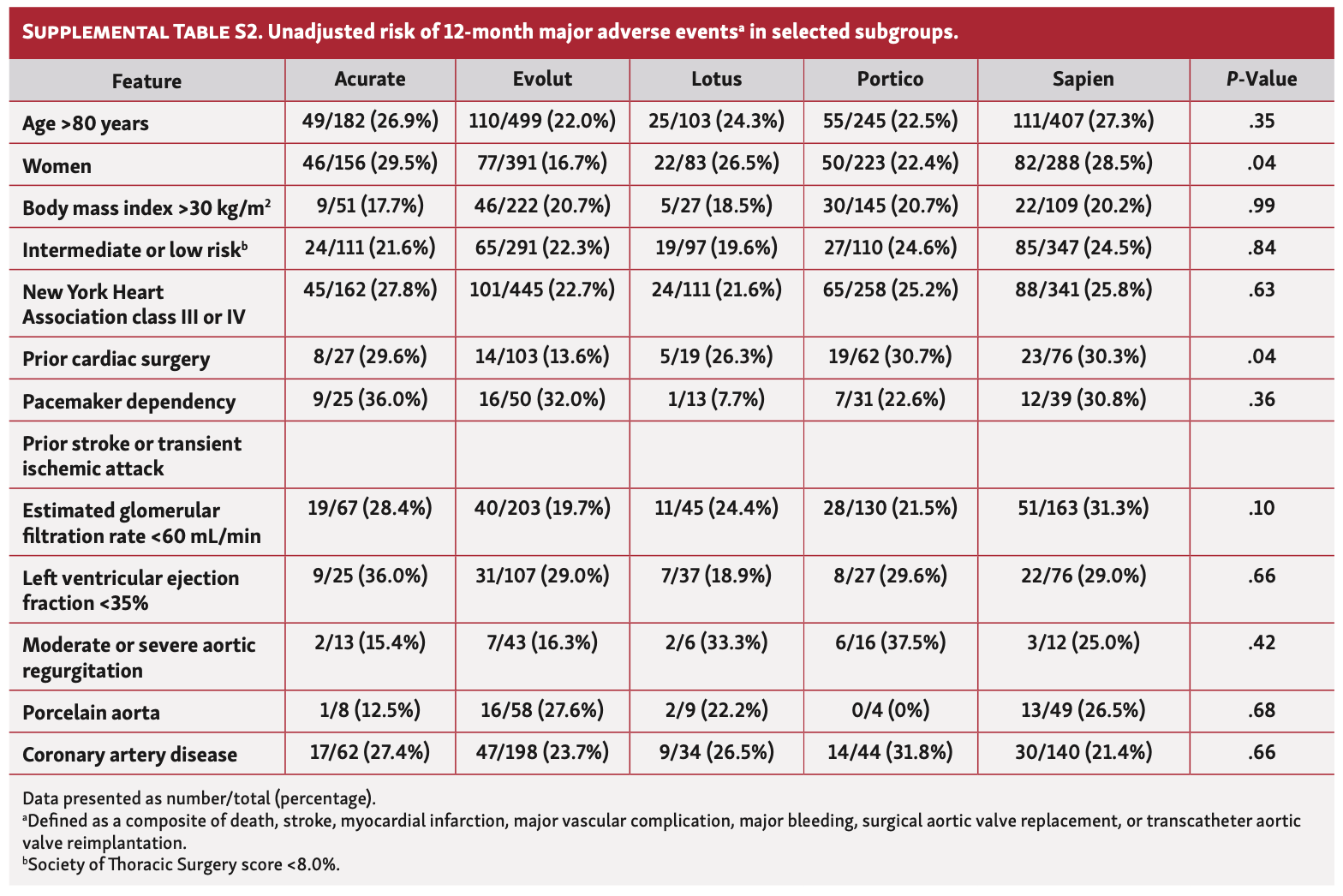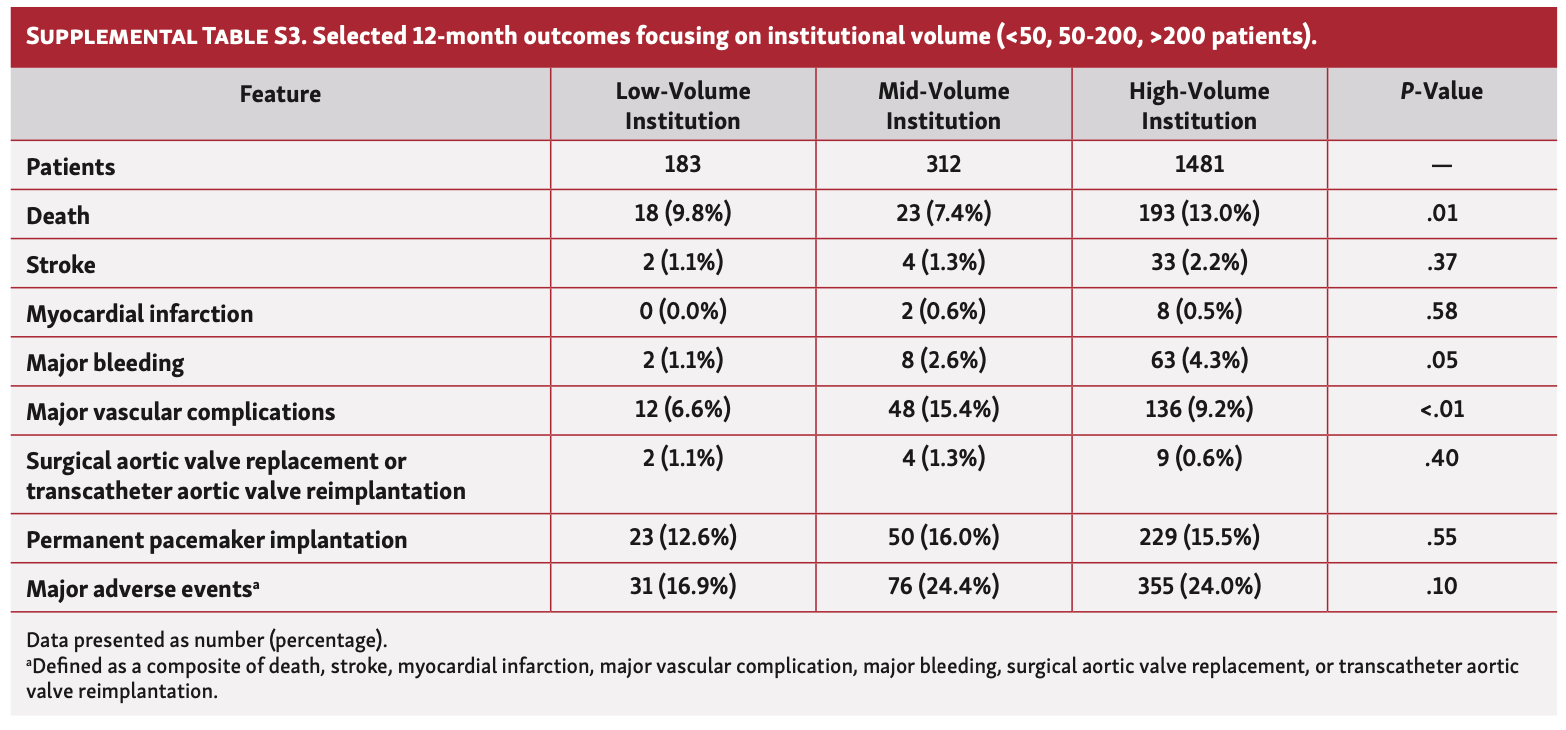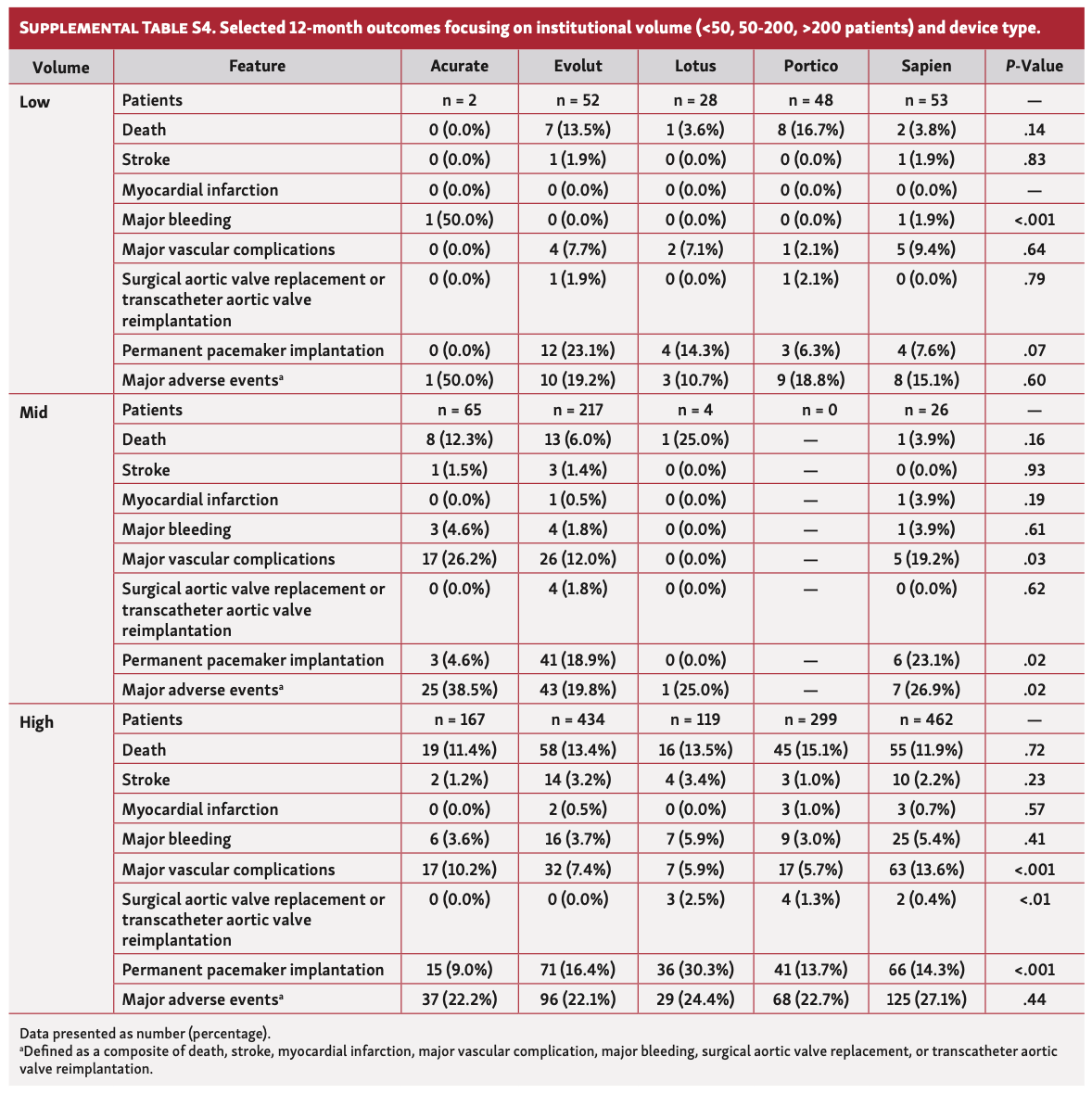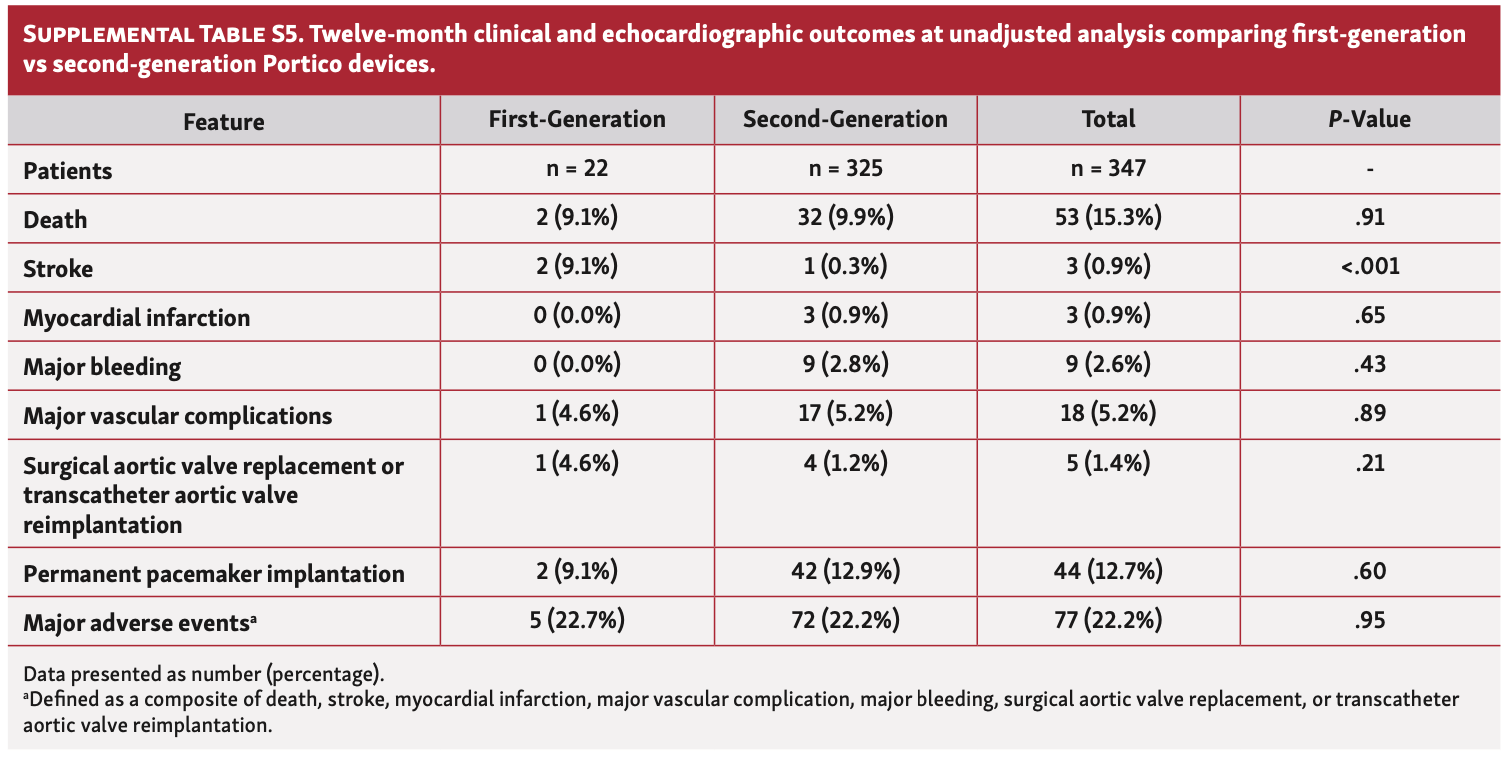Comparing the Safety and Effectiveness of Five Leading New-Generation Devices for Transcatheter Aortic Valve Implantation: Twelve-Month Results From the RISPEVA Study
Abstract
Objectives. The management of severe aortic stenosis has been revolutionized by the introduction of transcatheter aortic valve implantation (TAVI), especially in patients at intermediate, high, or prohibitive surgical risk. There is uncertainty, however, regarding the comparative effectiveness and safety of contemporary TAVI devices. Methods. We queried detailed data from the ongoing national Italian TAVI registry and compared baseline features, procedural details, and 12-month outcomes of Acurate Neo (Boston Scientific), Evolut Pro/R (Medtronic), Lotus (Boston Scientific), Portico (Abbott Vascular), and Sapien/Sapien S3 Ultra (Edward Lifesciences) transcatheter aortic valves. Several endpoints were collected and appraised, including the composite of death, stroke, myocardial infarction (MI), major bleeding, major vascular complication, surgical aortic valve replacement and transcatheter aortic valve reimplantation, which were deemed major adverse events (MAEs). Results. A total of 1976 patients were included, with 234 treated with Acurate, 703 with Evolut, 151 with Lotus, 347 with Portico, and 541 with Sapien. Twelve-month events were not significantly different among the 5 devices, including death (P=.29) and MAE (P=.21), with the notable exception of major vascular complications, which were more common with Acurate and Sapien (P<.001) and permanent pacemaker implantation, which was more frequent with Lotus and Evolut (P<.001). Differences in MAE were more pronounced in women and subjects with prior cardiac surgery, with the lowest event rates in the Evolut group. Propensity-score adjusted analysis suggested that Acurate, Evolut, Portico, and Sapien were all associated with similarly favorable results, whereas adverse events were more evident with Lotus (P<.05). Conclusion. Leading current-generation TAVI devices offer similarly favorable results at mid-term follow-up.
J INVASIVE CARDIOL 2021;33(5):E320-E327. Epub 2021 March 19. doi:10.25270/jic/20.00438
Key words: aortic stenosis, new-generation device, transcatheter aortic valve implantation, transcatheter aortic valve replacement
The management of severe aortic stenosis has been revolutionized by Alain Cribier’s invention of transcatheter aortic valve implantation (TAVI).1,2 While the first iteration of TAVI was bulky and not refined, subsequent devices have dramatically improved procedural safety and early efficacy, with ensuing favorable impact on long-term effectiveness.2,3 Accordingly, indications to TAVI have progressively expanded from patients at prohibitive risk to subjects at high and even intermediate surgical risk.4,5
Heart team members, and interventional cardiologists in particular, now face a plethora of competing devices, mainly self-expanding (eg, Allegra [NVT], Acurate [Boston Scientific], Evolut [Medtronic], Lotus [Boston Scientific], and Portico [Abbott Vascular]), but also balloon-expandable ones (Sapien [Edwards Lifesciences] and Myval [Meril]).3,6,7 Accordingly, comparative trials are urgently needed for informed decision making. Notwithstanding recent reports from dedicated randomized trials such as CHOICE, SOLVE-TAVI, SCOPE I, and Portico IDE,8-11 observational studies offer the possibility to track real-world use of TAVI devices, describe their results at face value, and tentatively compare them after appropriate statistical modeling.
Indeed, we have recently reported on the short-term comparative effectiveness of 5 leading TAVI devices, utilizing the national Registro Italiano GISE sull’Impianto di Valvola Aortica Percutanea (RISPEVA) registry and highlighting key differences in baseline features, procedural aspects, and results, as well as 1-month outcomes.12,13 We hereby report on the mid-term follow-up of the same patient cohort, in order to confirm or disprove early results in light of the substantial event accrual typical of TAVI patients.
Methods
Details of the ongoing Italian RISPEVA registry, a nationwide observational study collecting data on patients undergoing TAVI, have been reported elsewhere in detail.12-15 Briefly, RISPEVA is an observational study using a dedicated electronic case report form, enforcing common definitions and processes, and including thousands of patients every year. Its design has been registered at clinicaltrials.gov (NCT02713932), all participating centers obtained institutional review board approval, and all patients provided written informed consent.
As previously reported, and as typical of real-world observational studies, all clinical procedures, from patient screening and selection to procedural features including device choice and ancillary medical management, were at the discretion of the local physicians. While RISPEVA collects details on any TAVI device, for the purpose of this work, which mirrors the prior study focusing on short-term outcomes with 5 leading TAVI devices, we included only cases in which TAVI was performed with Acurate Neo, Evolut Pro or R (combined in the Evolut group), Lotus (first generation), Portico, and Sapien or Sapien S3 Ultra (combined in the Sapien group). Notably, 22 patients (6.3% of all those receiving Portico) underwent TAVI with the first-generation Portico device, whose pivotal trial has been recently reported by Makkar et al.16 Postprocedural and discharge management were also at the physician’s discretion, but ambulatory follow-up was recommended 1-3 months after discharge, and then every 3-6 months thereafter.
Outcome definitions, ranging from procedural or device success to death, myocardial infarction (MI), stroke, major vascular complications, and major bleeding, were all based on the current Valve Academic Research Consortium statement.17 In addition, we defined a composite endpoint of major adverse events (MAEs) comprising death, MI, stroke, major vascular complications, major bleeding, and surgical aortic valve replacement or transcatheter aortic valve reimplantation.
Statistical analysis. Descriptive analysis was based on count (%) for categorical variables and mean ± standard deviation for continuous variables. Unadjusted analysis was based on chi-squared test for categorical variables and on analysis of variance for continuous variables. In addition, survival curves were created using the Kaplan-Meier method, comparing them with the log-rank test, primarily, and then with the Cox, Fleming-Harrington, Peto-Peto-Prentice, Tarone-Ware, and Wilcoxon tests for sensitivity purposes. Thereafter, we performed missing data imputation and then computed propensity scores for each head-to-head between-device comparison, eventually using such scores as weighted in a Cox proportional hazard model. In particular, propensity scores were obtained using as covariates the following variables: center, age, gender, body mass index, prohibitive risk, Logistic EuroSCORE, EuroSCORE II, STS score, New York Heart Association (NYHA) class III or IV, renal function, prior cardiac surgery, prior valvuloplasty, prior stroke or transient ischemic attack, coronary artery disease, porcelain aorta, severe tortuosity, left ventricular ejection fraction, peak aortic valve gradient, mean aortic valve gradient, aortic valve area, aortic regurgitation, local anesthesia, femoral access, percutaneous approach, embolic protection device, right ventricular pacing, pacing rate, predilation, device size, multiple TAVI devices, postdilation, and balloon diameter. Computations were performed with Stata 13 (StataCorp), and statistical significance was set at the 2-tailed .05 level, without multiplicity penalization.
Results
As previously stated,13 a total of 1976 patients were included, with 234 (11.8%) receiving Acurate, 703 (35.6%) receiving Evolut, 151 (7.6%) receiving Lotus, 347 (17.6%) receiving Portico, and 541 (27.4%) receiving Sapien, with a follow-up of 12.0 ± 12.7 months. As reported in detail elsewhere, the groups were significantly different for several baseline features, including age, gender, body mass index, indication for TAVI, risk score, and NYHA class (all P<.05) (Table 1). Similarly, significant differences in procedural features were evident, ranging from anesthesia to access, approach, sheath size, device size, and postdilation (all P<.05) (Table 2).
Clinical and echocardiographic outcomes accrued up to 12 months of follow-up showed similar rates of death, stroke, MI, major bleeding, surgical aortic valve replacement or repeat TAVI, and MAE (all P>.05) (Table 3; Figures 1 and 2). However, major vascular complications appeared less common with Portico, while the rate of pacemaker implantation was lower with Acurate (both P<.05) (Figure 3). Other endpoints also appeared different across devices, including NYHA class, left ventricular ejection fraction, aortic gradients, aortic regurgitation, mitral regurgitation, and systolic pulmonary artery pressure (all P<.05).
After propensity-score adjustment, all differences became non-significant, with the notable exception of major bleeding (which appeared less common with Evolut vs Lotus; P=.03), major vascular complication (which appeared less common with Evolut vs Lotus; P=.04), surgical aortic valve replacement or repeat TAVI (which appeared less common with Acurate vs Lotus [P=.049] and Sapien vs Lotus [P=.03]), and pacemaker implantation (which appeared less common with Evolut vs Lotus [P<.01] and Sapien vs Lotus [P<.01]) (Supplemental Table S1).
Exploratory analysis suggested that the risk of MAE was substantially similar across the 5 devices in most subgroups (Supplemental Table S2), including advanced age, obesity, intermediate or low surgical risk, and NYHA class III or IV (all P>.05). However, Evolut appeared associated with the lowest rate of MAE in women (P=.04) and in patients with prior cardiac surgery (P=.04). Moreover, the impact of institutional volume on overall and device-specific outcomes was appraised for hypothesis-generating purposes (Supplemental Tables S3 and S4, respectively). No consistent association between volume and clinical outcomes was apparent, with some events (eg, death and major vascular complications) actually occurring less commonly in low-volume institutions. Finally, sensitivity analysis excluding patients receiving first-generation Portico devices confirmed the main results in terms of direction and magnitude of effects. Notably, new-generation Portico appeared associated with a lower risk of stroke in comparison with old-generation Portico (Supplemental Table S5).
Discussion
This comprehensive comparative-effectiveness study, focusing on 5 leading new-generation TAVI devices used for the management of severe aortic stenosis, has the following implications: (1) after a successful TAVI procedure with current devices, event rates remain low despite the inherent baseline risk; (2) most adverse outcomes occur with a similar frequency with Acurate, Evolut, Lotus, Portico, and Sapien devices; (3) Lotus appears associated with a higher rate of adverse events in comparison to other devices; and (4) Evolut may possibly be superior in terms of comparative effectiveness in women and in patients with prior cardiac surgery.
In less than 2 decades, TAVI changed from an experimental procedure that could be offered only for palliation in inoperable patients to a leading cardiovascular treatment capable of competing successfully with a time-tested intervention such as surgical aortic valve replacement.2,3 Yet, as is typical of many interventional cardiology procedures, multiple TAVI devices are now available, leading to uncertainties in decision making. On top of price and device-specific experience, which can easily be factorized, each TAVI device can be appraised using multiple dimensions, including design, outer size, flexibility, range of valve sizes, deployment technique, landing, and presence of skirt, among many others. Moreover, clinical evidence on outcome rates with each device should be borne in mind for competent and well-considered device decisions.18
Randomized trials represent the gold-standard tool to quantify outcome rates and compare competing treatments, and indeed it is important to carefully consider the results of recent and past trials on TAVI, including CHOICE, Portico IDE, SCOPE I, and SOLVE-TAVI, which all support the use of Acurate, Evolut, Portico, and Sapien devices.19,20 Systematic reviews, pairwise meta-analyses, network meta-analyses, and umbrella reviews may also, albeit in a weaker model, provide information on comparative effectiveness, pooling direct and indirect estimates of effect.21,22 In addition, non-randomized studies appear informative, as they represent accurate snapshots of real-world device use, and also indirect comparative data, if using appropriate adjustment means.23,24 Indeed, our present analysis, which details the 12-month results after TAVI with 5 leading new-generation devices, supports findings of prior comparative randomized trials, expanding their results on the many comparisons that can be generated. In particular, we found that Acurate, Evolut, Portico, and Sapien were all associated with favorable clinical results in terms of safety and efficacy. Conversely, unadjusted and adjusted analyses suggested that Lotus was inferior to the other devices analyzed. Finally, we examined specific subgroups to determine whether they benefited from a specific device, and found that Evolut was associated with particularly favorable results in women and patients with prior cardiac surgery.
Obviously, further studies are warranted, including longer-term follow-up of the RISPEVA dataset. Moreover, as soon as sufficient data on other devices have been collected, we aim to compare the outcomes of TAVI with Allegra and Myval in comparison with other leading TAVI devices.25-27 Eventually, the ideal clinical research tool to compare different TAVI devices would be a platform randomized trial, ie, a large-scale, pragmatic, randomized trial performed within the context of a large all-comer registry, such as RISPEVA.23,24 In any case, technical developments are commonplace even within each device life cycle, as clearly shown by iterative improvements in all devices hereby studied, including Portico. Accordingly, early and long-term results from trials employing older versions of any device should be appraised attentively in light of such device refinements.28,29
Study limitations. This work has several limitations, which have been previously specified in detail12-14 and of course include the non-randomized design. In addition, the reader should be cognizant of the lack of external event adjudication, the need for missing data imputation for selected variables, and the risk of type I error inflation due to multiple testing. Accordingly, our findings should mainly be viewed as descriptive and hypothesis generating.
Conclusion
Most leading current-generation TAVI devices offer favorable results at mid-term follow-up, despite some differences in design and size, with similar clinical outcomes irrespective of the chosen device. Whether refinements to Lotus device have improved its comparative safety and efficacy remains to be proven in dedicated clinical studies.
From the 1Unità Operativa di Interventistica Cardiovascolare, Pineta Grande Hospital, Castel Volturno, Italy; 2Unità Operativa di Emodinamica, Santa Lucia Hospital, San Giuseppe Vesuviano, Italy; 3Department of Cardiology, IRCCS Policlinico San Donato, San Donato Milanese, Milan, Italy; 4Cardiothoracic and Vascular Department, University Hospital Pisa, Pisa, Italy; 5Divisione di Emodinamica, Dipartimento di Scienze Cardiache, Toraciche e Vascolari, Policlinico Santa Maria alle Scotte, Siena, Italy; 6Centro Cardiologico Monzino, IRCCS and Department of Biomedical and Clinical Sciences “Luigi Sacco”, University of Milan, Milan, Italy; 7Fondazione CNR G. Monasterio Ospedale del Cuore, Massa, Italy; 8Department of Biomedical Sciences, Humanitas University, Rozzano, Italy; 9Institute of Cardiology, Fondazione Policlinico Universitario A. Gemelli IRCCS, Università Cattolica del Sacro Cuore, Rome, Italy; 10Division of Cardiology, CCU and Interventional Cardiology, Cardiovascular Research Center, University Magna Graecia, Catanzaro, Italy; 11Clinical and Interventional Cardiology Unit, Cardio-Thoracic Center, Istituto Clinico Sant'Ambrogio, Gruppo San Donato, Milan, Italy; 12Division of Cardiology, Department of Emergency and Organ Transplantation, University of Bari, Bari, Italy; 13Department of Medico-Surgical Sciences and Biotechnologies, Sapienza University of Rome, Latina, Italy; 14IRCCS NEUROMED, Pozzili, Italy; and 15Mediterranea Cardiocentro, Napoli, Italy.
Funding: The RISPEVA study was supported by unrestricted grants from Edwards Lifesciences and Medtronic.
Disclosure: The authors have completed and returned the ICMJE Form for Disclosure of Potential Conflicts of Interest. Dr Petronio reports grants and consulting income from Abbott, Boston Scientific, GADA, and Medtronic. Dr Biondi-Zoccai reports consultant income from Cardionovum, Innovheart, Meditrial, and Replycare. The remaining authors report no conflicts of interest regarding the content herein.
Manuscript accepted July 28, 2020.
Address for correspondence: Giuseppe Biondi-Zoccai, MD, Department of Medico-Surgical Sciences and Biotechnologies, Sapienza University of Rome, Corso della Repubblica 79, 04100 Latina, Italy. Email: giuseppe.biondizoccai@uniroma1.it
- Cribier A, Eltchaninoff H, Bash A, et al. Percutaneous transcatheter implantation of an aortic valve prosthesis for calcific aortic stenosis: first human case description. Circulation. 2002;106:3006-3008.
- Giordano A, Biondi-Zoccai G, Frati G, eds. Transcatheter Aortic Valve Implantation: Clinical, Interventional, and Surgical Perspectives. Cham, Switzerland: Springer Nature Publishing; 2019.
- Gatto L, Biondi-Zoccai G, Romagnoli E, Frati G, Prati F, Giordano A. New-generation devices for transcatheter aortic valve implantation. Minerva Cardioangiol. 2018;66:747-761.
- Mack MJ, Leon MB, Thourani VH, et al; PARTNER 3 Investigators. Transcatheter aortic-valve replacement with a balloon-expandable valve in low-risk patients. N Engl J Med. 2019;380:1695-1705.
- O'Sullivan CJ, Reardon MJ, Søndergaard L, Treede H, Jüni P, Windecker S. Will the Evolut low risk trial change my practice? EuroIntervention. 2019;15:e1072-e1076.
- Sharma SK, Rao RS, Chandra P, et al. First-in-human evaluation of balloon expandable transcatheter heart valve in the treatment of severe symptomatic native aortic stenosis: the MyVal-1 study. EuroIntervention. 2020;16:421-429.
- Cuevas O, Moreno R, Pascual-Tejerina V, et al. The Allegra transcatheter heart valve: European multicentre experience with a novel self-expanding transcatheter aortic valve. EuroIntervention. 2019;15:71-73.
- Abdel-Wahab M, Mehilli J, Frerker C, et al; CHOICE Investigators. Comparison of balloon-expandable vs self-expandable valves in patients undergoing transcatheter aortic valve replacement: the CHOICE randomized clinical trial. JAMA. 2014;311:1503-1514.
- Thiele H, Kurz T, Feistritzer HJ, et al. Comparison of newer generation self-expandable vs. balloon-expandable valves in transcatheter aortic valve implantation: the randomized SOLVE-TAVI trial. Eur Heart J. 2020;41:1890-1899.
- Lanz J, Kim WK, Walther T, et al; SCOPE I Investigators. Safety and efficacy of a self-expanding versus a balloon-expandable bioprosthesis for transcatheter aortic valve replacement in patients with symptomatic severe aortic stenosis: a randomised non-inferiority trial. Lancet. 2019;394:1619-1628.
- Makkar RR, Fontana G, Jilaihawi H, et al. Possible subclinical leaflet thrombosis in bioprosthetic aortic valves. N Engl J Med. 2015;373:2015-2024.
- Giordano A, Corcione N, Biondi-Zoccai G, et al. Patterns and trends of transcatheter aortic valve implantation in Italy: insights from RISPEVA. J Cardiovasc Med (Hagerstown). 2017;18:96-102.
- Giordano A, Corcione N, Ferraro P, et al; Registro Italiano GISE sull’impianto di Valvola Aortica Percutanea (RISPEVA) Study Investigators. Comparative one-month safety and effectiveness of five leading new-generation devices for transcatheter aortic valve implantation. Sci Rep. 2019;9:17098.
- Giordano A, Corcione N, Ferraro P, et al; Registro Italiano GISE sull'impianto di Valvola Aortica Percutanea (RISPEVA) Study Investigators. Comparison of ProGlide vs. Prostar in patients undergoing transcatheter aortic valve implantation. Minerva Cardioangiol. 2019;67:443-449.
- Giordano A, Corcione N, Ferraro P, et al; RISPEVA (Registro Italiano GISE sull’impianto di Valvola Aortica Percutanea) Study Investigators. Outcome of patients undergoing transcatheter aortic valve implantation after prior balloon aortic valvuloplasty. J Invasive Cardiol. 2018;30:380-385.
- Makkar RR, Cheng W, Waksman R, et al. Self-expanding intra-annular versus commercially available transcatheter heart valves in high and extreme risk patients with severe aortic stenosis (PORTICO IDE): a randomised, controlled, non-inferiority trial. Lancet. 2020;396:669-683. Epub 2020 Jun 25.
- Kappetein AP, Head SJ, Généreux P, et al; Valve Academic Research Consortium-2. Updated standardized endpoint definitions for transcatheter aortic valve implantation: the Valve Academic Research Consortium-2 consensus document. EuroIntervention. 2012;8:782-795.
- Junquera L, Ferreira-Neto A, Guimaraes L, et al. Transcatheter aortic valve replacement in low risk patients. Minerva Cardioangiol. 2019;67:19-38.
- Costache VS, Moldovan H, Arsenescu C, Costache A. Aortic valve surgery of the 21st century: sutureless AVR versus TAVI. Minerva Cardioangiol. 2018;66:191-197.
- Makkar RR, Thourani VH, Mack MJ, et al; PARTNER 2 Investigators. Five-year outcomes of transcatheter or surgical aortic-valve replacement. N Engl J Med. 2020;382:799-809.
- Biondi-Zoccai G, Peruzzi M, Abbate A, et al. Network meta-analysis on the comparative effectiveness and safety of transcatheter aortic valve implantation with CoreValve or Sapien devices versus surgical replacement. Heart Lung Vessel. 2014;6:232-243.
- Morello A, Corcione N, Ferraro P, et al. Complications after transcatheter aortic valve implantation: an updated umbrella review. Curr Emerg Hosp Med Rep. 2019;7:227-233.
- Biondi-Zoccai G, Marullo AGM, Peruzzi M, et al. Last nail in the coffin for propensity scores in observational cardiovascular studies? J Am Coll Cardiol. 2017;69:2575-2576.
- Corcione N, Biondi-Zoccai G, Ferraro P, et al. Long-term follow-up of transcatheter aortic valve implantation with Portico versus Evolut devices. Am J Cardiol. 2020;125:1209-1215. Epub 2020 Jan 30.
- Harris AW, Pibarot P, Otto CM. Aortic stenosis: guidelines and evidence gaps. Cardiol Clin. 2020;38:55-63.
- Ando T, Briasoulis A, Panaich S. Advances in transcatheter aortic valve replacement. J Geriatr Cardiol. 2019;16:724-732.
- Spaccarotella C, Mongiardo A, De Rosa S, Indolfi C. Transcatheter aortic valve implantation in patients at intermediate surgical risk. Int J Cardiol. 2017;243:161-168.
- Barbanti M, Buccheri S, Rodés-Cabau J, et al. Transcatheter aortic valve replacement with new-generation devices: a systematic review and meta-analysis. Int J Cardiol. 2017;245:83-89.
- Costa G, Tamburino C, Barbanti M. Degeneration of prosthesis after transcatheter aortic valve implantation. Minerva Cardioangiol. 2019;67:57-63.




























